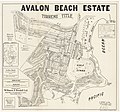The Pittwater and Northern Beaches area was formerly inhabited by the Garigal or Caregal people in a region known as Guringai country. [3]
European settlement
Avalon was named after the mythical Avalon, a legendary island in Celtic languages mythology. According to legends, Avalon was an earthly paradise and the final resting place of King Arthur. [4]
The first land grant in the area was 240,000 square metres (60 acres) to John Farrell in 1827. In 1833 a 4.9-square-kilometre (1,200-acre) land grant was made to Australia's first Catholic priest, John Joseph Therry, by Governor Bourke. A further grant of 280 acres made in 1837 meant that Therry's holdings covered most of the peninsula from Newport to Whale Beach. [5] He built a church in this area but his plans for a settlement never eventuated. Therry fought hard for the recognition of the Catholic Church in the colony. After he died, the land was left to the Jesuit order and was then sold to help finance the rebuilding of St Mary's Cathedral in Sydney. [6] In the 1920s, the area was still known as 'Priest's Flat'. Arthur J Small handled a subdivision in 1921 and chose the name Avalon. [4] Lots were sold for £100 each and included two year's free membership in the local golf club. [6]
Significant housing developments took place during the 1920s. The architect Alexander Stewart Jolly designed a number of houses that were built in the Avalon area in that period. Loggan Rock was a flamboyant log cabin combined with a stone tower; the combination of logs and rocks gave rise to the name. The house is heritage-listed. [7] Careel House is a bungalow made of stone that was quarried in the area. Nowadays it is on the Whale Beach side of the boundary. It is also heritage-listed. [8] Hy Brasil, located near Clareville, was built in 1936, but was originally known as The Gem. Later it was bought by Ted Herman, son of the painter Sali Herman, who changed the name, using the name of a mythical island west of Ireland. It is heritage-listed. [9] A sandstone cottage known as Wickham, designed by Walter Burley Griffin, was demolished with council approval in 1994.
Another significant development was the creation of Ruskin Rowe in 1950. This street was designed as an estate by the architect Harry Ruskin Rowe, son of the architect Thomas Rowe. Rowe created covenants to preserve the character of the estate, but they have been ignored to an extent over the years. Nevertheless, the estate is heritage-listed because of its historic significance, as well as its scientific significance in preserving the bushland environment of the area. [10]












